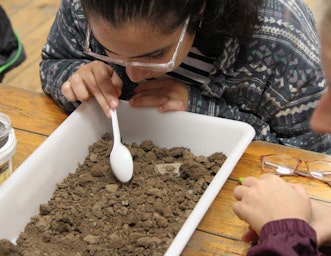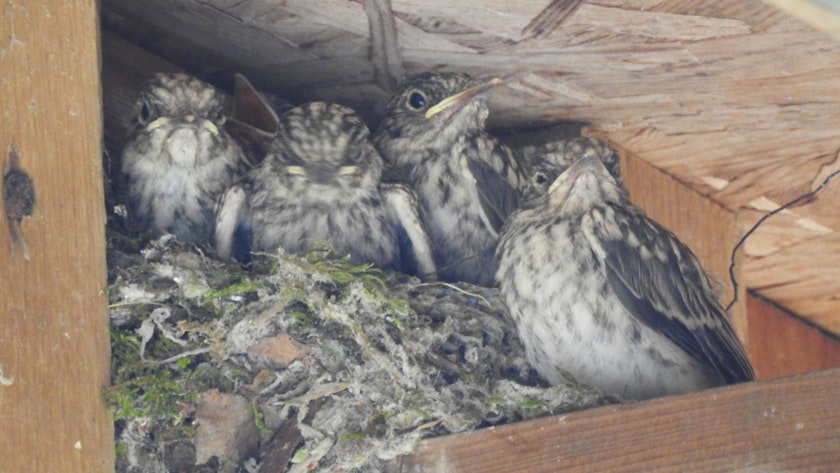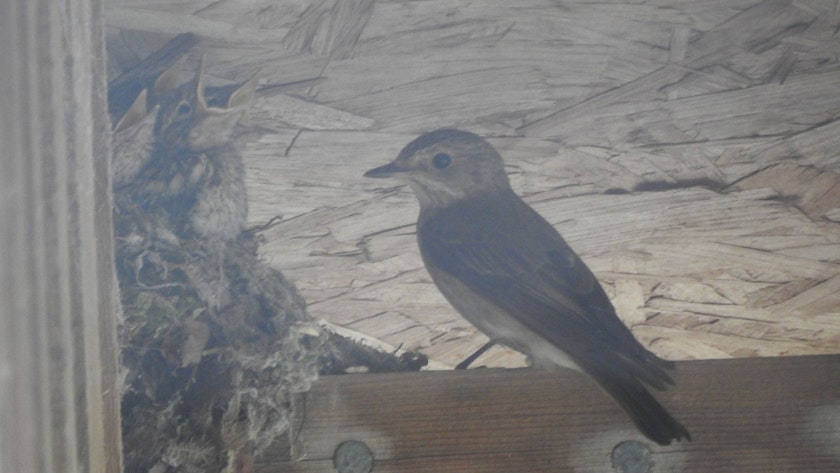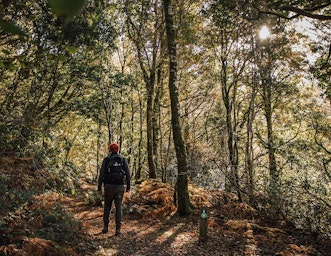
Once a common sight for garden birdwatchers, the Spotted Flycatcher has suffered serious decline in the UK in recent years. Joe Downie looks at some who made CAT their summer home, and explores how we can help these and other struggling species.
One of the last migrant birds to return after over-wintering in Africa, the Spotted Flycatcher (Latin name: Muscicapa striata, or Gwybedog Mannog in Welsh) arrives in late April or early May and can be seen across the UK through to September.
Here at CAT we spotted our first of the year on 17 May, closely followed by its cousin the Pied Flycatcher on 21 May. The adult birds quickly got to work building nests to rear their young. Rather unusually, this year we were able to keep an eye on two Spotted Flycatchers nests right in the middle of the CAT visitor centre. The external eves of an engineering workshop were the ideal spot for one nesting pair, and the other made their home above the door of our woodland workshop (which luckily has two doors, allowing us to use a different entrance once the female was sitting on her eggs).

An ideal home
In both cases, the nests were built near woodland edges, giving the adult birds the ideal conditions to be able to perch on a branch and then dart out with deadly accuracy into the clearing to catch some juicy winged insects. This is their main way of feeding, and makes them easy to spot despite their small size (about the same as a house sparrow) and “drab” appearance – well, this is how the guidebooks describe them, personally I think their speckled crown is rather beautiful.
In terms of habitat, the Spotted Flycatcher is one of many woodland birds which really does need the space provided by clearings within and between trees. In prehistoric times, such spaces would have been made by large mammals, such as elephants and wooly mammoths, crashing through the woodland, as well as by natural tree-fall. These days, with large woodland mammals now absent, creation and maintenance of broadleaf woodland glades and rides needs to be done sensitively, by humans (or by reintroduced mammals like bison) as part of a sustainable approach to woodland management that will have multiple benefits for wildlife as well as people. The birds are also found in wood pasture, and in many villages with suitable trees.

Going hungry
But back to those Spotted Flycatcher nests. Sadly, the woodland workshop nest failed, with the three chicks hatching but perishing just a few days before they were due to fledge. More happily, in the engineering workshop nest a successful brood of four chicks was raised over two weeks, fledging on 5 July.
The reason for the first nest failure is likely to be a lack of insects on the wing. Their main diet is flying insects, such as moths, butterflies, damselflies and craneflies. Wasps and bees are made safe to eat by rubbing the sting end on their perch to remove it. If the weather is bad, they can search trees and shrubs for other insects, but if poor weather persists many nests fail as these smaller invertebrates tend to be eaten by the parents rather than fed to the young. It’s possible this is what happened in our failed nest.
Certainly, our butterfly surveys so far this year, especially for early June, have suggested very low butterfly numbers overall. We experienced a very dry spring and then a cool and wet spell in late May and early June, which could have had an impact on insect abundance.
In our nearby woodland, Coed Gwern, it was a similar story for the Pied Flycatchers, where only around 20% of chicks fledged. Yet our swallow families, who have been busy since May making dozens of nests all over the CAT site, appear to have had a good breeding season, with some raising second broods. Unfortunately, the Spotted Flycatchers didn’t appear to try for a second time as we didn’t see them on site after early July.

Long term trends
As ever, it’s hard to draw definitive conclusions from one season, but that’s where longer term recording efforts come in. Sadly, the long-term picture isn’t looking good. Older birdwatchers might remember Spotted Flycatchers as common birds of UK gardens, parks and orchards, but a population decline of between 90 and 94% between 1967 and 2018 has set alarm bells ringing.
Due to the rapid decline, the bird is now a UK “Red List” species, which means it’s in big trouble, and needs our help (see box). As with many other migratory species, pinning down the exact reasons for the decline is very difficult. The decline may be due to a number of factors, including: habitat loss and lack of food in their African wintering grounds; difficulties on the migration route; a general fall in the abundance of insects; the changing climate (which underpins many of these factors); increased nest predation; and changes in, or decline of, woodland management in Britain.
A helping hand
To give them a helping hand in the face of these threats, the advice for woodland managers is to:
- Provide open nest boxes and/or half coconut shells in suitable woodland habitats;
- Retain ivy and other climbing plants to provide cover for natural nest sites;
- Create and maintain open woodland features such as glades and rides through selective felling and pruning, and prevent woodland becoming too dense;
- Encourage a diversity of structure within the field and shrub layers, through control of grazing levels (e.g. by deer) to encourage an increase in insects and food availability whatever the weather.
Such measures may also help other woodland birds that are struggling, and give a boost to woodland biodiversity more generally. Here at CAT we manage our woodlands with a nature-first approach, and we provide advice and training to help others to do the same. In gardens, meanwhile, we can help all birds by gardening in ways that support insect life, without the use of harmful chemicals, growing plants that will provide seeds and berries, and creating nesting spaces with hedges, shrubs and nest boxes.
The Spotted Flycatcher is just one of 70 bird species on the UK Red List, accounting for around one in three UK bird species and nearly double the number that were on the list 25 years ago. Also on the list are other species found in the CAT woodlands such at Willow Tit and Woodcock, and species familiar to us all, such as Swift, House Sparrow and Starling. Urgent action on climate change and habitat loss is needed to help them back from the brink, but action at a more local level to provide food, water and shelter can make a big difference for struggling birds. We hope that by managing our woodlands and gardens in ways that support these magical creatures, we’ll be providing a summer residence for Spotted Flycatchers for many years to come, whilst inspiring many more people to do what they can to support wildlife in woodlands, gardens and green spaces across the UK.
What do we mean by a ‘Red List species’?
Red Lists are globally recognised as a way of identifying the level of threat faced by different species on a national, regional and global level, and are an important tool in bringing attention to areas of concern.
The International Union for the Conservation of Nature’s (IUCN) Red List was created in 1964 through a collaboration of worldwide government agencies, conservation organisations, universities, museums, and other members. Categories span a continuum from ‘Least Concern’ for abundant and thriving species to ‘Critically Endangered’ for those that are likely to
disappear in the near future. A Red List species is anything that is assessed to be Critically Endangered, Endangered or Vulnerable.
In the UK, ‘Birds of Conservation Concern’, commonly known as the ‘UK Red List for birds’ is produced by experts from the number of conservation organisations, and is updated roughly every six years. It assesses 245 species with breeding, passage or wintering populations in the UK, designating each as Red, Amber or Green. Birds can be added to the Red List for a number of reasons, including being threatened with global extinction, undergoing severe population decline in the UK, or seeing severe contraction of Chicks being fed at one of the CAT nesting sites (photograph taken from their UK breeding range. a distance with zoom so as not to disturb the nest site).
About the author
Joe is one of our long-term residential volunteers, helping with woodland and other habitat management on the main CAT site and in our neighbouring woodlands. He has a background in environmental campaigning, and is a keen walker, runner, cyclist and (bad) birder.
References available on request
- Woodland
- Nature and Wildlife
- Autumnwatch
- Winterwatch
Related Topics
Related news


CAT joins Protecting our Planet Day for schools
28th November 2023
Why we teach… ecological assessment
22nd April 2023
Helping hands: volunteering at CAT
17th November 2022EMAIL SIGN UP
Keep up to date with all the latest activities, events and online resources by signing up to our emails and following us on social media. And if you'd like to get involved and support our work, we'd love to welcome you as a CAT member.

